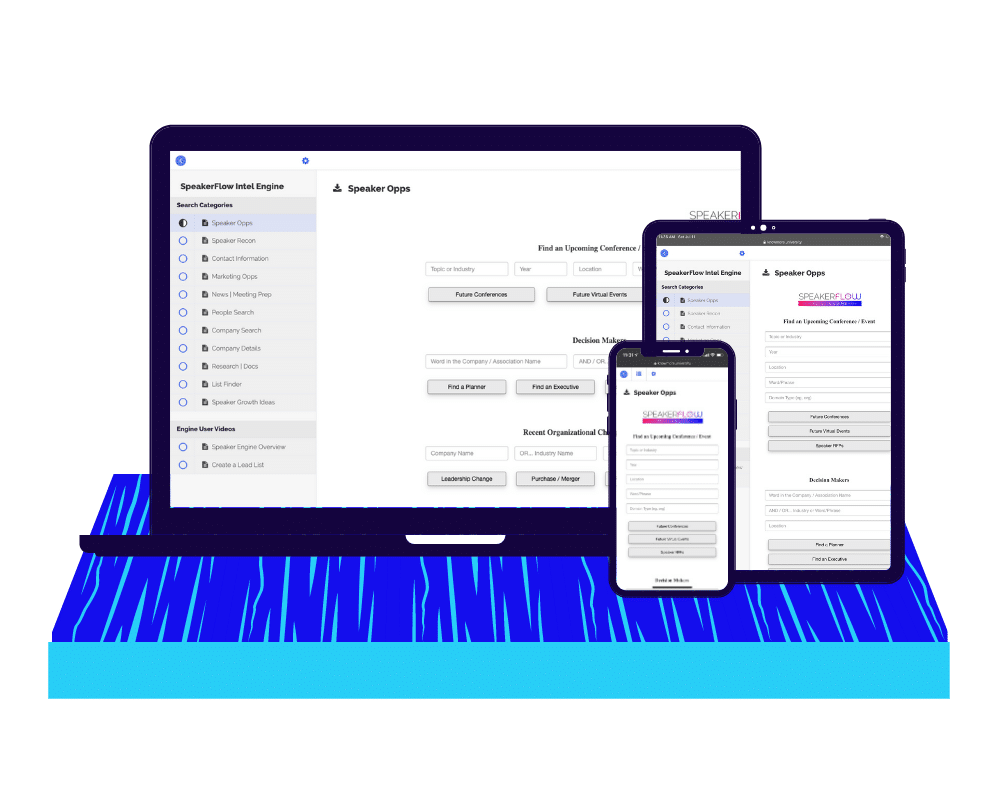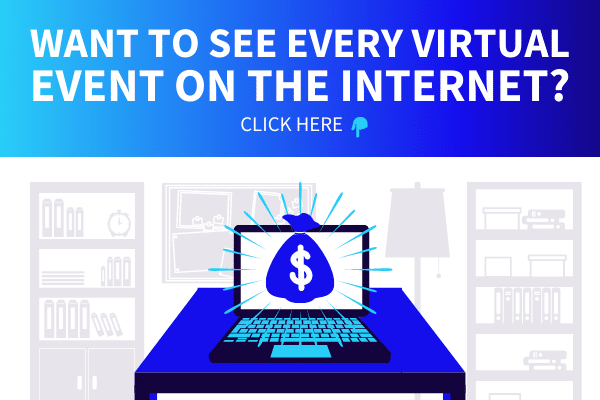When the coronavirus pandemic began in early 2020, the speaking industry faced an enormous set of challenges. Live events suddenly canceled, pending contracts came to a halt, and many speakers who had previously excelled suddenly felt lost. However, like any obstacle, these challenges collectively presented speakers with an opportunity to grow and, by extension, prepare should a similar public health crisis emerge in the future. Much of this growth centered around the topic of this guide: how to find virtual event leads.
Setting aside the COVID-19 pandemic, virtual events have been on the rise for the last 20 years, and they’re not going away. If anything, they’re becoming more and more popular with each year, as event organizers look for ways to diversify their content and make events more accessible. Consequently, as a speaker, learning to prospect for – and close – virtual speaking opportunities isn’t just a way to prepare for the next worldwide health emergency. It’s a chance to stand out from your fellow speakers and stay on the cutting edge of speaking industry innovation.
With that in mind, this article is all about how to find your next (or first) virtual event. We’ll also cover some basic information about virtual speaking. That way, even if it’s brand new for you, you’ll have a list of virtual event clients before you know it. 👍
How does a virtual event work?
If you’ve never attended or spoken for a virtual event before, let’s start with the basics. Overall, there are four types of virtual events, including webinars, virtual conferences, and internal or external hybrid events. The first of these, webinars, are completely virtual and generally function as one-off, 40-60 minute events. Although they can be available for a price, most webinars are free and available to a worldwide audience. This allows the host to deliver the webinar’s educational content live or through a recording without having to worry that their audience isn’t “getting their money’s worth”. It also allows them to use the webinar as a lead-generation mechanism and upsell attendees into subsequent purchases.

One the flip side, virtual conferences almost always charge admission and are delivered live. Like an in-person conference, these typically include a complex agenda made up of keynotes, breakout sessions, expert panels, and community engagement or networking opportunities. The only difference is that, rather than meeting in person, attendees view each presentation in a virtual conference room, like Zoom.
Finally, the last two kinds of virtual events – internal or external hybrid events – combine aspects of both live and virtual presenting. The former is used for internal company events, such as company-wide training, quarterly meetings, or sales kick-off meetings for international or remote companies. The latter is used for external company events, such as user or industry conferences or trade shows. In either case, content is simultaneously delivered live and streamed online, so attendees can participate virtually or in-person after paying for admission.
Why are virtual events so popular?
So, why the sudden explosion of virtual events, you ask? Two things: accessibility and budget.
When it comes to accessibility, in-person events can be challenging for many reasons, such as location, scheduling, or even weather. A company hosting an event in my home state of Minnesota, for example, not only has to fly employees there. They also must plan the event when it’s convenient for those employees to be out of the office. Plus, there’s a decent chance of harsh weather and snow, both of which can cause last-minute flight or event cancellations. That’s a lot of risk and lost time for both attendees and organizers.

Additionally, when it comes to budget, those risks and that time also add up in dollars. Flying employees to the venue, covering the cost of their stay and their meals, hiring speakers – all of these things can total tens of thousands of dollars, which is then reflected in attendance fees. Combine that cost with the travel needed for live events and you can see why attendees may be hesitant to bite the “cost of admission” bullet.
But, for a virtual event, many of those problems are non-existent. Because there’s no venue, all costs related to travel, hotels, food, and venue rental disappear. There’s also no travel time before or after the event, no concerns about weather or illness, and no additional material cost, as most of the event information can be shared virtually.
Together, these advantages not only give virtual event organizers the chance to invite attendees from all over the world. They also dramatically improve the ROI of the event, as a whole, making it easier for organizations to offer admittance at a low cost. In terms of accessibility and budget, a virtual event is a win for everyone involved!
Why would I speak for a virtual event?
When I say, it’s a win for everyone, don’t think I forgot about you, as a speaker, either. Many of the aforementioned benefits of virtual events also affect speakers, including the lack of travel and the quick turnaround time between events.
In addition, compared to an in-person event, speaking for a virtual event allows you to:
- Speak to a broader audience, as attendees can view your presentation from around the world.
- Give multiple presentations at the same event (or speak at multiple events altogether) within a few days.
- Negotiate your speaking fee with more flexibility, as you no longer have to worry about costs for your travel, time, and print materials.
- Build your reputation as a virtual speaker, which is not only growing in demand but also has considerably less competition. In other words, a smaller percentage of speakers have proved they can be equally impactful in a virtual environment, so if you can, you’re sure to stand out.
On top of these benefits, speaking for a virtual event carries many of the same benefits as an in-person event. You’re still able to showcase your expertise. You still have the chance to turn your speaking presentation into a long-term contract or revenue stream, such as consulting or a workshop series. The only difference is that, rather than working with clients face-to-face, you’ll see them through a webcam instead. Sounds like the dream, right?
How can I find virtual speaking opportunities?
At this point, I hope it’s clear that speaking for a virtual event isn’t necessarily better or worse than speaking for an in-person event. However, virtual speaking does come with undeniable benefits for everyone involved and, as a result, is only going to grow. In fact, according to a 2020 study by Grand View Research, the global virtual event market was valued at $77.98 billion USD in 2019 and is expected to grow by up to 23% in the coming decade.
With that in mind, as speakers, event organizers, and business professionals worldwide lean into the world of virtual events, let’s talk about how you can find them. That way, whether you’re looking at them as a temporary or long-term source of revenue, you’ll be able to grow your speaking income with ease.
Reconnect with clients that hired you for live events.
First and foremost, if you want to find a virtual event, start by reaching out to your past clients. In many cases, someone that hired you for an in-person event already knows your skills. They’re just busy and waiting for you to reach out. Additionally, because you’ve already worked with them, you likely already know the challenges they’re facing. Maybe it’s a sales shortage or their team isn’t working cohesively. In any case, you just need to jump back in their inbox and say, “I get the sense that you’re struggling with X, Y, and Z. I can help!”

When reaching out to past clients, the key to segueing into another speaking opportunity is what I call the “Three R’s Method.” First, reconnect with them. They’re a human being, after all, so before they’re willing to spend more money on you, they’ll want to know (a) that you remember them and (b) that you valued your first opportunity with them.
Second, after reconnecting, review what your past client has told you. What organizational challenges have they alluded to? What successes have they seen since you last worked with them? And, perhaps most importantly, what success did they see from the event for which they first hired you? Your goal in this step is to look for things you can build off of in Step #3.
Lastly, after reviewing any new information, recommend ways you can help. If their team is unmotivated, suggest a motivational speech. If they’re training a bunch of new employees, suggest team-building exercises or company-wide training. Then, mention that you can do it all virtually to save them time, money, and stress. Between these benefits and your existing relationship, trust me – it’ll be a hard deal to refuse.
Offer a virtual speaking program on any of your speakers bureau profiles.
After reaching out to previous clients, another way to find your next virtual event is through speakers bureaus. If you’re currently working with a bureau or two, you know that a bureau sales rep can only represent you as well as you represent yourself. So, if you don’t have your speaking materials organized, they won’t be able to sell efficiently on your behalf. If you’ve updated your signature presentations and forgot to tell them, your bureau sales are going to suffer.

Along those lines, if you’re represented by any bureaus and branching into virtual speaking, communicate that your bureau rep(s). Make sure “virtual” is mentioned in your program descriptions, your bio, your certifications (if you’re an eSpeakers Certified Virtual Presenter). Anywhere your name shows up on any bureau’s website, it should be clear to the reader that you’re available for virtual events and prepared to knock them out of the park.
When working with a bureau, it’s also important to communicate the kind of events you’re looking for. If you’re only looking for virtual events, for instance, make that very clear. If you’re open to hybrid or in-person events, share that information, too. The last thing you want, when working with a bureau salesperson, is to book an event that’s ill-suited to you. It makes both you and the bureau look disorganized, whether it’s an in-person or virtual event.
See every virtual event on the internet with the Intel Engine.

Finally, if you want to see every virtual event available online, there’s no better tool than the Speaker Intel Engine. Designed by speaker and sales expert Sam Richter, this tool allows you to run highly complicated Google searches and, ultimately, find qualified leads in a matter of minutes.
If you’re looking for virtual events for Fortune 500 companies, for example, you can find leads in 2-3 minutes. The same goes for virtual events in finance, in technology, in human resources – it’s all fair game. Plus, with the Intel Engine, you won’t just find event information. You’ll also be able to find contact information for event organizers, background on the company hosting each virtual event, and news about challenges facing their industry. What’s better than that?
That said, as actions speak louder than words, I’ll leave it to our CEO (and Intel Engine co-creator) Taylorr to explain the Intel Engine’s inner workings in more detail. Just click the video below to learn more! 😊
All in all, regardless of how you find your next virtual event, I hope this guide gave you some clarity and confidence to enter the virtual speaking market. After all, it’s only going to grow, so it’s only fitting that a kickass speaker like yourself comes along for the ride. 😉
For more information, check out our previous virtual speaking guides including “8 Traits Of An Exceptional Virtual Speaker” and “12 Features Of The Most Impactful Virtual Keynotes”.
Additionally, for technology suited to virtual event sales (and designed to help you outshine other virtual speakers) check out our operating system. Book a demo or visit our operating system page to learn more!





